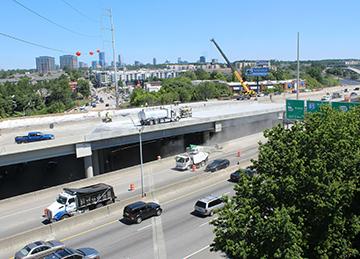Georgia – A host of improvements are advancing to the next stage of the 85 Study conducted by Gwinnett County and the Georgia Department of Transportation (GDOT) of an 18-mile stretch of Interstate 85 between interstates 285 and 985.

I-85 Bridge rebuild
Data collection and input from stakeholders as well as the community contributed to the advancement of several managed lane options, each exceeding an estimated cost of $1 billion.
One alternative would add one managed lane in each direction and convert existing High-Occupancy Toll (HOT) lanes to express lanes to create a two-lane bi-directional system.
Another option would add two bi-directional commercial vehicle lanes and retain the existing HOT lanes.
A third possibility is to add two managed lanes in each direction and convert the existing HOT lanes to mixed managed lanes to achieve a three-lane bi-directional system.
The final managed lane alternative that advanced to the next screening stage would add three managed lanes in each direction and convert HOT lanes to express lanes for a four-lane bi-directional system with two express lanes and two commercial vehicle lanes.
Other freeway improvements for traffic flow and safety include:
- Consolidating entrance and exit ramps to I-285 North, I-285 South, Northcrest Road, and Pleasantdale Road for an estimated $500 million to $1 billion.
- Widening State Road 316 by one lane in each direction from I-85 to Sugarloaf Parkway and extending the southbound express lane merge for an estimated $200 million to $500 million.
- Adding an auxiliary lane on I-85 in each direction between I-285 and Jimmy Carter Boulevard for an estimated $100 million to $200 million.
- Constructing collector-distributor systems between Indian Trail-Lilburn Road and Beaver Ruin Road for an estimated $100 million to $200 million.
- Additional improvements under consideration include interchange upgrades, operational changes, and policy and smart infrastructure adoption.
The 85 Study team will further refine the list of alternatives under consideration in both Tier 2 and Tier 3 Screening. At the conclusion of the Tier 3 Screening stage, the study team will make final project recommendations, which include an implementation plan.
